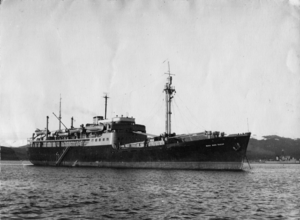ARA Bahía Buen Suceso
 |
|
| History | |
|---|---|
|
|
|
| Name: | Bahía Buen Suceso |
| Builder: | Halifax Shipbuilding Ltd., Halifax, Nova Scotia |
| Yard number: | 17 |
| Commissioned: | 1950 |
| Identification: | Call sign : LOPQ |
| Fate: | Sunk, 21 October 1982 |
| General characteristics | |
| Tonnage: | 3,834 gross register tons (GRT) |
| Length: | 102.48 m (336 ft 3 in) |
| Beam: | 14.36 m (47 ft 1 in) |
| Draught: | 5.64 m (18 ft 6 in) |
| Propulsion: | 2 × Nordberg 5-cylinder 3,750 hp (2,796 kW) diesel engines, 2 shafts |
| Speed: | 14.5 knots (26.9 km/h; 16.7 mph) |
| Capacity: | 100 passengers |
| Crew: | 46 |
| Service record | |
| Part of: | ARA Naval Transport Service |
| Operations: | Falklands war |
ARA Bahía Buen Suceso (B-6) was a 5,000-ton fleet transport that served in the Argentine Navy from 1950 to 1982. She took part of the Falklands War (Spanish: Guerra de las Malvinas) as a logistics ship tasked with resupplying the Argentine garrisons scattered around the Falkland Islands. Captured by British forces on 15 June after running aground at Fox Bay, she sank in deep waters while being used as target practice by the Royal Navy on 21 October 1982.
The ship was constructed by Halifax Shipbuilding Limited at Halifax, Nova Scotia, Canada, and commissioned in June 1950 for service under the Transporte Navales command. In 1958 she carried the crew of the new aircraft carrier ARA Independencia to the United Kingdom. The vessel participated in numerous Antarctic supply missions. On 10 March 1969 she made a trip to Europe, visiting cities such as Genova, Brugge, Rotterdam, Amsterdam, Portsmouth, Edinburgh, and Dublin. The purpose of the trip was to carry wheat to Europe and bring military items to Argentina. While sailing through the English Channel, she collided with the tanker Asprella and was repaired at the Ferrol shipyard in Vigo, Spain. In 1972 she began regular service between the continent and the Falkland Islands.
...
Wikipedia
